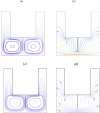Thermosolutal convection in a baffled curvilinear porous cabinet filled with magneto radiative hybrid nanofluid
- PMID: 41022838
- PMCID: PMC12480827
- DOI: 10.1038/s41598-025-02743-z
Thermosolutal convection in a baffled curvilinear porous cabinet filled with magneto radiative hybrid nanofluid
Abstract
This study focuses on optimizing the thermosolutal performance of a wavy porous cabinet with a T-shaped cold baffle, highlighting the utilization of a radiative Cu-[Formula: see text] [Formula: see text]-water hybrid nanoliquid and diverse heating strategies. The purpose of this work is to evaluate the influence of these factors on hydromagnetic thermosolutal behavior under the influence of various thermal boundary conditions. By employing an efficient Higher Order Compact (HOC) scheme, the Navier-Stokes equations in streamfunction (ψ)-vorticity (ζ) form and energy as well as species transport equations are solved. In a novel approach, the study introduces a T-shaped cold baffle in the middle of the container, introducing complexity to the porous configuration. The investigation encompasses three distinct heating scenarios: uniform heating and soluting of the lower border (Case-1), linear heating and soluting (Case-2), and non-uniform heating and soluting (Case-3), while maintaining the side walls at cold and low concentration. The upper wall remains adiabatic. The results reveal a significant improvement in energy transfer across all cases, with an increase of 467.12% for Case-1, 470.98% for Case-2, and 387.78% for Case-3 as the radiation parameter ([Formula: see text]) is varied from 1 to 10. In contrast, solutal transfer experiences a slight decline, quantified as 3.09% for Case-1, 2.05% for Case-2, and 6.07% for Case-3. These findings emphasize the superior thermosolutal performance of Case-1, where an optimized heating strategy significantly enhances the overall system efficiency. This study provides valuable insights for improving thermal management systems in practical applications. Notably, in areas such as electronic device cooling, heat exchangers, and porous industrial processes, the findings offer the potential for enhanced efficiency and reliability.
Keywords: Different heating strategy; Energy and solutes transfer; Higher order compact scheme (HOC); Hybrid nanofluid; Irreversibility; T-shaped baffle; Thermal radiation.
© 2025. The Author(s).
Conflict of interest statement
Declarations. Competing interests: The authors declare that they have no known competing financial interests or personal relationships that could have appeared to influence the work reported in this paper.
Figures


























References
-
- Hansda, S. & Pandit, S. K. On the analysis of thermosolutal mixed convection with thermophoresis effects in a wavy porous cabine. Numerical Heat Transfer, Part A: Applications.85(16), 2640–2663 (2023).
-
- Hansda, S., Chattopadhyay, A. & Pandit, S. K. Analysis of thermsolutal performance and entropy generation for ternary hybrid nanofluid in a partially heated wavy porous cabinet. International Journal of Numerical Methods for Heat & Fluid Flow34(2), 709–740 (2023).
LinkOut - more resources
Full Text Sources

